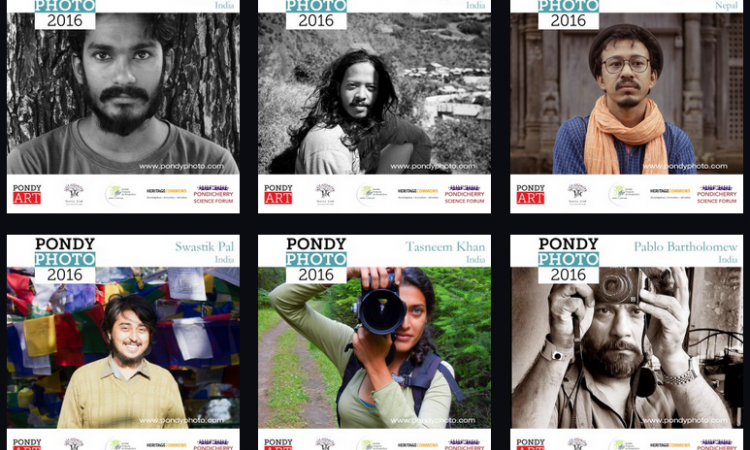
A picture is worth a thousand words, but more often than not, insightful pieces of art and photography find themselves confined to affluent salons and galleries. While employing art and photography to address social issues is common in the West, the concept of public art is still in its incipient stages here in India. High-quality thematic art and photo exhibits across the cities in the recent past have been promising. One such exhibition is the latest edition of Pondy ART’s photo biennale, PondyPHOTO.
The festival runs through August 27 to September 11, 2016 at Puducherry’s Old Port premises.
The idea to get art out there was born out of Puducherry-resident Kasha Vande’s desire to break conventions and make art more accessible. “Public art is completely different from gallery art. From the format to the venue, PondyPHOTO attempts to move away from the elitism associated with art and take it directly to the people,” says Kasha.
This year’s theme could not be more apt. Water, as a subject, cannot be dismissed--from everyday struggles of quality and access to the larger issues of environment and climate change, water encompasses and pervades all. The fest’s 2016 edition promises to combine quality art with discussions and interactions on critical issues around water.

Awareness is not lacking, initiative is
Through open exhibits, the fest plans to engage with a larger group of people in a more direct way. People remember direct experience and relate better to evidences of experience such as photos or videos. “You cannot expect everyone to understand engineering jargon or scientific concepts. People relate to stories. And photography is an excellent interface to help people relate to real issues,” says advisory member of PondyPHOTO 2016 Ravi Agarwal who is the director of NGO, Toxics Link.
The festival pairs high quality photography with strong and relevant subject matter. Also in the offing are panel discussions, interactive sessions with local fishermen and thematic public discussion to lend credibility to the entire exercise. “When people come with their mind set around a certain theme, the probability of learning about the subject is increased,” asserts Agarwal. He will be presenting an illustrated talk on ecology as a counter image on August 28.
Weekends are packed with workshops and round tables. “Photographer Waswo X Waswo will be mediating the art and water round table featuring notable figures like Pablo Bartholomew and Sheba Chachchi. This one’s a must-attend for artists and activists alike,” says Kasha. Documentary and commercial films revolving around water will be screened at the fest as well.
Presentations and exhibits by internationally acclaimed photographers Pablo Bartholomew and James Whitlow Delano are also on the table. Delano will be hosting the seven-day-long interactive session on documentary story-telling workshop which encourages participants to research, build and present story ideas around water. A two-day introductory workshop on documentary film-making led by visual storyteller Senthil Kumaran has been planned as well.

Euphoria, despair and everything in between
Water as a subject has been broached passionately by photographers--amateur, professional and photo-journalists--alike; characterising the people it nurtures and the many emotions it embodies. From euphoria to despair, photographs on display subtly reveal the emotional connection people share with water.
Photographs from Seema Krishnakumar’s Land of lost reflections brings to life the other side of Kerala’s burgeoning backwater tourism industry while Joydeep Mukherjee’s pictures paint a thousand words on how Kolkata celebrates the rigorous Hindu ritual of Dondi along the famed Kalighat. Arko Datto’s Gangetic Interludes is woven around the complex relationship between the mighty Ganges and the people dependent on it.
Ravi Agarwal’s installation, 'Evening has come', inspired by the kattumaram (catamaran) wielding marginal fishermen of Thanthirayan Kuppam, Puducherry will be on throughout the fest at the Kiran Nadar Hall.
Prasiit Sthapit’s documentation of the changing course of river Narayani in Nepal, Swastik Pal’s Hungry Tide and Zishaan Akbar Latif’s Majuli Eroding put the consequence of changes in local climate, geography and hydrology in perspective.
Bartholomew’s latest project, Memento Mori, featuring prints from partially-damaged Kodachrome films on how the Bangladeshis dammed the Feni river with might and muscle will be showcased as well.
Contests galore
Involving the youth--school students in particular--is an integral part of the overall design. A bunch of photography and story-telling contests have been announced. From exploring water bodies in their vicinity to discussions on possible improvements to local water and sanitation are all part of the fest’s community outreach. A community contest on farmers’ best practices on water harvesting and a special women-only contest on gender and water have also been announced. Click here for more details.
The festival promises a little something to the amateur photographers and environment activists in each one of us. Get set to take the plunge.